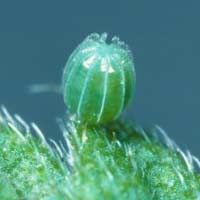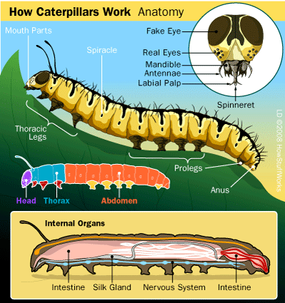Quck answer
Caterpillars are the larval stage of moths and butterflies. They have a soft, segmented body and a head with six small eyes. Caterpillars use their strong jaws to feed on leaves and other plant material. They have a unique digestive system that allows them to break down tough plant fibers and extract nutrients. Caterpillars also have a pair of antennae that help them navigate their environment and sense danger. As they grow, they molt their skin several times until they reach their final size. Finally, they spin a cocoon or chrysalis and undergo metamorphosis to become a moth or butterfly.
Wild Animals
The Anatomy of a Caterpillar: A Food Processing Tube

The life of a caterpillar begins with a textured and patterned egg and finishes with a chrysalis, which acts as a protective covering in which the caterpillar undergoes a metamorphosis. Once it emerges from the chrysalis, it is a fully grown butterfly or moth. It remains the same species as before, but no longer resembles a caterpillar. Between the egg and the chrysalis, the caterpillar goes through a series of molts, during which it sheds its skin that is too tight and then consumes it. This provides the caterpillar with a bit of extra nourishment and removes any traces that may attract predators. The stage between each molt is known as an instar, and most caterpillars go through five of them, growing quickly and consuming a lot of food to fuel their metamorphosis. The length of each instar varies depending on the caterpillar’s species, food intake, and weather. Molting provides caterpillars with more room to move, but it does not erase what they have learnt about their environment; typically, their memory lasts for one or two molts.
A caterpillar’s body is essentially a tube that processes and stores food. The caterpillar has a set of mouthparts that enable it to chew its food, which usually consists of leaves and other plant parts. The mouth leads to an incredibly lengthy intestine with fore and hind parts. Here, the caterpillar’s digestive system breaks down the food and eventually stores it in a fat layer known as the fat body.

Most caterpillars are soft on the inside and fuzzy (or prickly) on the outside
2008 HowStuffWorks
The caterpillar has six legs attached to the thorax that allow it to move about. Additional pairs of prolegs support and move the length of the caterpillar’s abdomen. These prolegs end in small, hook-like suction cups known as crochets. Since prolegs do not have segments or joints, they are not considered genuine legs, so even though it may not appear so, a caterpillar is a six-legged creature. Most caterpillars move in one of two ways: some crawl, moving each pair of prolegs and their true legs in sequence, while others, such as the caterpillars of geometer moths, lack prolegs in the middle part of their abdomen. These caterpillars move in small arches, appearing to measure the surface under them.
The remainder of the caterpillar’s body enables it to survive and move around. Spiracles are holes in the caterpillar’s sides through which it breathes. Antennae provide sensory input, particularly related to taste and smell. In many species, false eyes assist in distracting predators while actual eyes enable the caterpillar to see. Hairs, spines, and quills known as setae might deter predators and even carry toxins and irritants. An osmeterium, found on swallowtail caterpillars, produces a foul-smelling substance that deters predators.
Caterpillars also have spinnerets, or silk-producing organs, in their heads. Next, we’ll investigate how silk can save a caterpillar’s life, why it affects how quickly a caterpillar grows, and why it is critical to a successful metamorphosis.
To eat salad or escargot?
Most caterpillars are plant-eaters, with a few exceptions. Certain butterflies, such as the Liphyra brassolis in Australia, lay their eggs in ant nests. These eggs are camouflaged with waxes and pheromones, or odor chemicals, to avoid detection by the nearby ants. Once hatched, the caterpillars feed on ants and ant larvae. Some caterpillar species even consume larger prey, such as snails, which they tie to twigs using silk in several Hawaiian species.
FAQ
1. What are caterpillars?
Caterpillars are the larval form of butterflies and moths. They are characterized by their long, segmented bodies and multiple pairs of legs. Caterpillars are known for their voracious appetites and can consume large amounts of leaves and other vegetation.
2. How do caterpillars move?
Caterpillars move using their many pairs of legs. They have specialized muscles that allow them to contract and expand their bodies, allowing them to move forward. Some species of caterpillars also have small hooks on their legs that help them grip onto surfaces.
3. What do caterpillars eat?
Caterpillars are herbivores and primarily feed on leaves and other vegetation. Some species of caterpillars are highly specialized and only feed on specific types of plants.
4. How do caterpillars defend themselves?
Caterpillars have several defense mechanisms to protect themselves from predators. Some species have spines or hairs on their bodies that can be irritating or toxic to predators. Others have the ability to release a strong odor or mimic the appearance of a poisonous species.
5. How do caterpillars transform into butterflies?
Caterpillars transform into butterflies through a process called metamorphosis. They spin a cocoon or chrysalis and undergo a dramatic transformation inside, eventually emerging as an adult butterfly or moth.
6. How long do caterpillars live?
The lifespan of a caterpillar varies depending on the species. Some live only a few weeks, while others can live for several months.
7. How do caterpillars communicate with each other?
Caterpillars communicate with each other through a variety of methods, including chemical signals and tactile cues. Some species also use vibrations or sounds to communicate.
8. What is the purpose of silk in caterpillars?
Caterpillars use silk for a variety of purposes, including building cocoons or webs, creating a protective case around themselves, and attaching themselves to surfaces.
9. How do caterpillars benefit the ecosystem?
Caterpillars play an important role in the ecosystem as a food source for other animals and as pollinators. Some species of caterpillars also help to control pest populations by feeding on harmful insects.
10. How do humans use caterpillars?
Humans use caterpillars in a variety of ways, including as a food source in some cultures and as a model organism for scientific research. The silk produced by some species of caterpillars is also used to make textiles.
11. Are all caterpillars harmful?
Not all caterpillars are harmful. While some species can be toxic to predators or cause skin irritation in humans, many caterpillars are harmless and play important roles in the ecosystem.





Leave a Reply